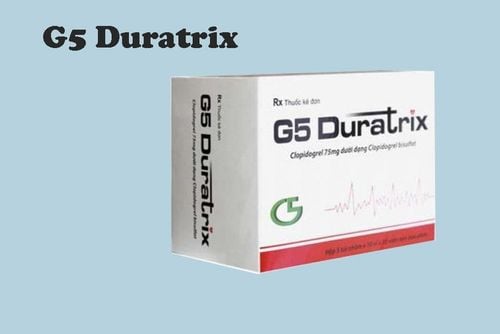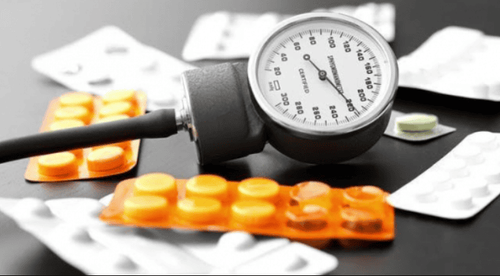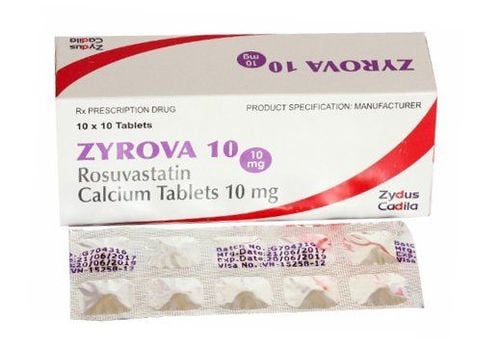This is an automatically translated article.
Ischemic heart disease, also known as chronic coronary syndrome, is a condition caused by narrowing of the coronary arteries that restricts the supply of blood, oxygen and nutrients to the heart, causing angina pectoris. So what drugs do patients with ischemic heart disease take?
1. Causes and risk factors for ischemic heart disease
1.1. Causes of ischemic heart disease Causes of myocardial ischemia can be divided into the following groups:
Atherosclerotic ischemic heart disease: This is the main cause of ischemic heart disease. coronary artery diseases. Non-atherosclerotic ischemic heart disease: Rare and conditions in this group include congenital coronary artery disease (coronary artery malformation, fistula, misplaced origin), inflammatory coronary artery disease (such as Kawasaki) or non-atherosclerotic coronary artery spasm. 1.2. Risk factors for ischemic heart disease Risk factors for ischemic heart disease or chronic coronary syndromes can be divided into two groups: Unmodified risk factors. The modifiable and modifiable risk factors are as follows:
The nonmodifiable risk factors are:
Age: The risk of coronary heart disease increases with age. At age 70 and beyond, the prevalence of symptomatic coronary artery disease increases to 15% of men and 9% of women and to 20% at age 80. Gender and menopausal status: Coronary artery disease are more common and have an earlier onset in men. In post-menopausal women, the rate of coronary artery disease increases rapidly and is equal to that of men after the age of 65 due to the role of sex hormones. Family history: For patients with atherosclerosis, family history is an important factor as atherosclerosis can present in the first generation with men before 55 years of age and women before 65 years of age. age. Ethnic factors: The age-related coronary heart disease mortality rate in the South Asian population is 50% higher than in the indigenous white population in developed countries and lower in the black population. The prevalence of coronary artery disease tends to increase sharply in some populations in East Asia. The modifiable risk factors are:
Psychological stress: Increased stress at work, lonely life, depression are important factors that increase the risk of atherosclerosis. Smoking: Smoking increases the risk of coronary artery disease by up to 50% with a 60% higher mortality rate (possibly up to 85% in smokers). The risk of coronary artery disease is increased by about 25% with secondhand smoke. Inflammatory factors and infection: Atherosclerosis involves an ongoing inflammatory process from the beginning of lesion formation. As the process progresses to the point of an acute thrombotic event, infection aggravates the disease. Sedentary lifestyle: People who are physically active have a lower risk of coronary artery disease than people who lead a sedentary lifestyle. Alcohol, beer: People who drink alcohol increase the risk of cardiovascular diseases. Hypertension: Hypertension is an independent risk factor for coronary artery disease. People with chronic ischemic disease with high blood pressure should control blood pressure <130/80 mmHg. Dyslipidemia: There is a stable, persistent, independent association between total cholesterol (TC) or low molecular weight cholesterol (LDL-C) and atherosclerotic cardiovascular events. . Diabetes is one of the major cardiovascular risk factors for atherosclerotic cardiovascular disease. Diabetes is associated with a 2-fold increase in cardiovascular events (including coronary artery disease, stroke and overall vascular disease-related mortality).
2. What are the signs and symptoms of ischemic heart disease?
If you have the following symptoms, the patient should pay attention because it may be a manifestation of ischemic heart disease:
Angina pectoris:
Location: Usually behind the sternum and is a region ( rather than a single point), pain may radiate to the neck, shoulders, hands, jaw, epigastrium, and back. The most common is the direction that spreads to the left shoulder and then to the inside of the left hand, sometimes down to the fingers 4, 5. Circumstances where the pain occurs: Usually occurs when the patient exerts himself, after stress or when When experiencing cold, after eating too much or when smoking, the pain quickly subsides and disappears within a few minutes when reducing the above factors. Nature: Feeling of pain like constriction, strangulation, or pressure in the chest and sometimes a feeling of cold, burning in the chest area. Some patients have symptoms of shortness of breath, headache, nausea, sweating, weakness... Duration: The pain usually lasts for a few minutes (3 - 5 minutes), can be longer but usually does not. more than 20 minutes. In cases where the patient's pain persists longer and occurs even at rest, it should be directed to unstable angina or myocardial infarction. Shortness of breath: The patient may experience shortness of breath accompanied by angina, or when exertion, when doing housework, the symptoms of dyspnea worsen when the patient rests and also finds it difficult to breathe.
Some other symptoms: The patient may not have obvious angina, but only feel chest tightness, chest discomfort, or feel like a stiff jaw after exertion,...
Symptoms When examining patients with ischemic heart disease:
Count pulse, count heart rate: If the patient is ischemic to the lower wall, it causes ischemia of the atrioventricular node, causing bradycardia. In the case of sympathetic nerve activation will cause tachycardia at rest. However, a fast, irregular heartbeat can also be a sign of an ischemic arrhythmia or abnormal heart muscle conduction. Blood pressure measurement: The purpose is to diagnose hypertension, or hypotension in patients (due to heart failure or drug overdose). Cardiac examination: Examine for signs of dilated myocardium, left ventricular hypertrophy, cardiac dyskinesia on palpation, heart murmur (in case of acute myocardial ischemia), aortic stenosis, regurgitation. mitral (due to papillary muscle dysfunction, congenital abnormalities of the heart). Examination of signs of heart failure: The doctor palpated the heart beat and found an enlarged heart shadow, tachycardia on examination, auscultation of the lungs with moist rales in the two lung fields, or signs of pleural effusion on examination (percussive percussion). , decreased alveolar murmur). Examination of liver enlargement, tenderness, distended neck veins, hepatic venous feedback, examination of both lower extremities. Examination for signs of peripheral artery disease: The doctor palpates the abdominal aortic aneurysm, palpates the carotid and extremity pulses, listens to the carotid, renal, and femoral pulses, evaluates the feeding of the lower extremities, detects stenosis and occlusion. circuit. Examine for signs of high cholesterol: Look for signs of cholesterol accumulation on the skin such as xanthoma on the skin, eyelids, on tendons, especially the Achilles tendon, suggesting familial hypercholesterolemia that occurs in humans as well. young. Check for other signs for differential diagnosis such as: palpation in pericarditis, costochondritis, signs of pneumothorax,... Laboratory investigations:
Tests should be done Practice in ischemic patients (chronic coronary syndromes) includes: Basic biochemical tests, resting electrocardiogram, possibly Holter ECG monitoring, straight chest X-ray, ultrasonography. resting echocardiogram, stress echocardiography,...
Basic biochemical tests: HS Troponin test to rule out acute coronary syndrome. In addition, blood count, liver function, kidney function, blood lipid index, blood sugar test, HbA1C screening for diabetes and, thyroid hormone test, thyroid ultrasound to evaluate function can also be done. thyroid (conditions that aggravate coronary artery disease). Electrocardiogram and Holter Electrocardiogram: Patients with stable angina have >60% of the ECG normal in addition to pain. Electrocardiogram in pain: Can see changes in T wave and ST segment (ST depression, negative T wave). However, even a normal ECG cannot rule out the diagnosis of ischemic heart disease. Straight chest X-ray: X-ray helps to evaluate pulmonary stasis, degree of cardiac chamber dilation, or to distinguish it from other causes. A chest x-ray should be performed in patients who are clinically atypical, have symptoms of heart failure, or are suspected of having another respiratory illness. Echocardiography: Transthoracic and 2D Doppler echocardiography has a role in assessing heart structure and function, helping to differentiate it from some other heart conditions that can also cause chest pain (such as hypertrophic cardiomyopathy with left ventricular outflow tract obstruction, aortic valve stenosis, pericarditis, etc.). In addition, ultrasound also helps to evaluate the area of myocardial ischemia (reduced regional movement), the procedure can be performed during chest pain or immediately after chest pain. Echocardiography also assesses myocardial tension, helping to detect heart failure with preserved EF, the goal being to account for the symptoms associated with exercise. Stress echocardiography : Give the patient physical exertion (cycling, running mat) or medication (dobutamine) then echocardiography to help diagnose regional dyskinesia of ischemic heart disease or recovery ability of the heart. heart muscle.
3. How is myocardial ischemia treated?
3.1. Lifestyle changes in ischemic heart disease Quit smoking. Healthy diet: Eat a lot of green vegetables, limit eating fatty foods, fast food, limit alcohol. Control your weight, exercise regularly every day. If you have a psychological disorder: Stress, depression needs to be treated. Get a flu shot every year. 3.2. Ischemic heart disease what drugs to take? Depending on the patient's medical condition and the cause of ischemic heart disease, the doctor will assign the patient to use medical treatment or intervention. Doctors can prescribe a combination of drugs, patients are required to use as prescribed by the doctor, not buy and use it themselves, increase or decrease the dose of drugs to avoid unwanted consequences:
Nitrate group:
Has the effect of dilating coronary artery and venous system, releasing nitric oxide (NO) and reducing preload, thereby reducing symptoms of angina. Includes:
Short-acting nitrates: Nitroglycerin spray or sublingual (dose 0.3 - 0.6 mg every 5 minutes, up to a maximum of 1.2 mg over 15 minutes), used for acute chest pain or Prophylaxis of angina after strenuous activities, strong emotions or cold weather, with immediate effect. Long-acting nitrates: If used regularly for a long time without a break or reduced in nitrate dose by about 10 to 14 hours, the effectiveness of the drug will be lost. Group of beta-blockers:
Beta-blockers are the first-line drugs in the treatment of chest pain in most patients with myocardial ischemia
Drugs help reduce ischemic burden, improve survival in patients with ischemic heart disease. patients with reduced left ventricular function or a history of myocardial infarction. The benefit of long-term beta-blocker therapy has been demonstrated in patients with chronic coronary syndromes. Beta-blockers should be used in all patients with reduced left ventricular systolic function (echocardiogram with an EF 40%) or in patients with a history of myocardial infarction, unless contraindicated. sympathetic beta blocker. The drugs that have been shown to reduce the risk of death are: Metoprolol succinate, Bisoprolol and Carvedilol,. Group of calcium channel blockers:
Divided into two groups Dihydropyridine (Amlodipine, Felodipine, Lacidipine, Nifedipine) and Nondihydropyridine (Diltiazem and Verapamil). Both of these groups have a role in improving myocardial oxygen delivery by reducing coronary resistance, increasing systemic arterial flow, decreasing myocardial contractility, decreasing systemic vascular resistance, and lowering blood pressure. reduce myocardial oxygen demand. However, calcium channel blockers have not been shown to significantly reduce mortality in patients with ischemic heart disease. Other groups of drugs:
Ivabradine : Controls heart rate and symptoms of angina in patients. Ivabradine can be used in combination with or instead of beta-blockers when patients are intolerant to beta-blockers Nicorandil: A nitrate derivative of nicotinamide used for the prevention and treatment of angina in the long term. long-term, can be combined with beta-blockers. Trimetazidine: A drug that regulates myocardial energy metabolism, helps to improve chest pain, reduce myocardial oxygen demand,. In addition, there are also drugs to prevent cardiovascular events in patients with ischemic heart disease (chronic coronary artery syndrome):
Antiplatelet drugs:
Aspirin: The drug works through inhibition. Irreversible cyclooxygenase (COX-1), is the cornerstone of treatment for the prevention of arterial thrombotic events. Aspirin 75-100 mg/day is indicated in patients with a history of myocardial infarction or coronary revascularization, or considered in patients with no history of myocardial infarction or revascularization. coronary artery disease but there is clear imaging evidence of coronary artery disease. Clopidogrel 75 mg/day is indicated in patients with ischemic heart disease in the above situation as an alternative to aspirin when the patient has a contraindication to aspirin. Aspirin in combination with a second antithrombotic agent (antiplatelet or other anticoagulant) should be considered for secondary thromboembolism prevention in patients with high bleeding risk and low thromboembolic risk. pulse is high. Lipid-lowering drugs:
Statins are indicated for all patients with ischemic heart disease with the goal of reducing LDL-C 50% from baseline (when the patient has not been treated with any anti-inflammatory drugs). blood lipids) and an LDL-C goal < 1.4 mmol/L (< 55 mg/dL). If the target is not achieved with the maximally tolerated statin dose, the addition of Ezetimibe or a PCSK9 inhibitor is recommended. ACE inhibitors and Renin-Angiotensin receptor blockers:
ACE inhibitors should be used in all ischemic patients with hypertension, diabetes, and fractional echocardiography. Left ventricular ejection fraction (EF) ≤ 40%, with chronic kidney disease, unless contraindicated to this class of drugs. ACE inhibitors should be considered in ischemic patients at very high risk of cardiovascular events. ARBs are recommended in patients with ischemic heart disease when ACE inhibitors are not tolerated. Hopefully the above information helps patients know more information about the signs, symptoms and treatment of ischemic heart disease. However, the patient is required to take the drug as prescribed by the doctor, not to self-treat at home, to increase or decrease the dose of the drug to avoid unwanted consequences.
Please dial HOTLINE for more information or register for an appointment HERE. Download MyVinmec app to make appointments faster and to manage your bookings easily.













